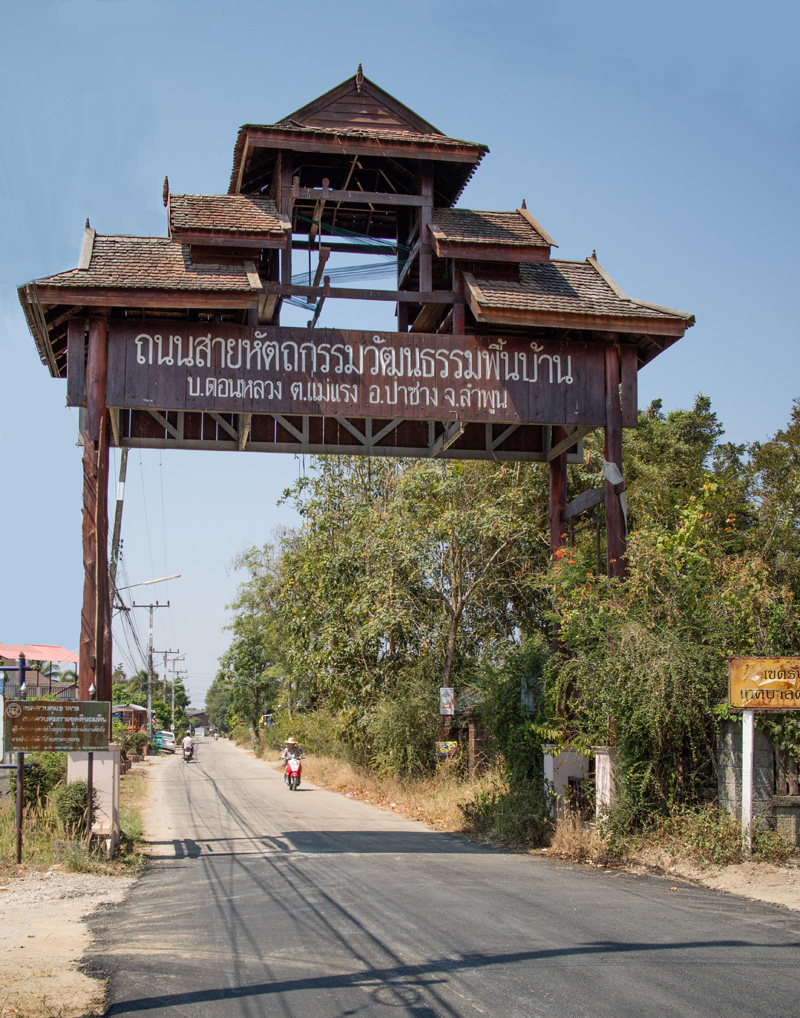
Want to shop for cotton fabrics and clothes with great selection and prices near Chiang Mai? Want get away from the madding tourist crowds of Chiang Mai and see the nearby countryside? Of course you do! Then read on and I’ll take you to the village of Pasang where you’ll find some of the best selection and prices for cotton apparel.
Cotton is king throughout northern Thailand. If you hear the clacking of an old wooden loom in the north, most likely a cotton fabric is being woven, not silk.

There is no better place to shop for quality cotton fabrics and apparel than in the town of Pasang.
Pasang, located in Lamphun Province, lies about 35 kilometers southeast of Chiang Mai and has a long tradition of cotton weaving. In fact when you shop in Chiang Mai at the big tourist markets such the Night Bazaar, Thanon Kon Durn (Walking Steet Market) or Anasorn Market, most of the cotton-wear sold by the vendors was woven and made in and around Pasang.

The Cotton-Craft Village of Ban Daun Luang

Within the township of Pasang at its southern end, there is Ban Daun Luang which has now become the center of cotton weaving and apparel making in the area.
Here you’ll find dozens of small and medium size stores that sell not only Thai-style apparel such as shirts, skirts, sarongs, scarves, pants, jackets and hats, but also rugs, placemats, pillows, curtains, pillow covers, bedspreads, mats, purses, handbags and just about anything else that can be made from cotton.

The clothing botiques you’ll find by strolling through Ban Daun Luang are just the tip of the iceberg. These establishments are also wholesale manufacturing businesses with most of their products being shipped to Chiang Mai, Bangkok and the southern beach cities to sell to the tourist trade. If you go to Phuket and buy a “Hill Tribe” style purse or a pair of fisherman pants, the odds are very high that it was made in or around this tiny little village.

The Village Weavers

In back of the botiques and stores, out of view of customers, you’ll often find women weaving cotton on old wooden looms. You may have to ask the botique owner if there is any weaving going on that you can see and they’ll readily take you back to the looms.


An experienced weaver producing a simple fabric (no brocades or complicated pattern) can produce 8-12 meters per day. Their shuttles (a device that carries the horizontal thread across the fabric) can be a blur as it moves so quickly across the fabric.
Don’t be shy about approaching their looms for a close look. The weavers are proud of their traditions and skill, and are happy that you’re interested in their work.
Prices

Selection and prices are phenominal! Prices can be 50% lower than what you’d find at the Chiang Mai street markets and the selection is much better. You’re shopping at the source. Bargaining is expected. Be prepared to pay the “farang price.” (To learn more about “farang prices”, please read my blog entry here.)
Getting There

It’s about a 45 minute drive from Chiang Mai to Pasang. The best and easiest way is to hire a driver for the day from Chiang Mai. They will know how to get to Pasang and may even know where Baan Daun Luang is located. A few tour operators have day trips to Lamphun and Pasang and these often will go to Baan Daun Luang. (Tour buses have started showing up at the village on weekends, so you know it’s becoming well known.)
From Chiang Mai: Take Highway 11 (a major freeway) south to Lamphun. Take HWY 1147 west into Lamphun City (You are now in Lamphun Province.) HWY 1147 will intersect with HWY 106 which is the old Lamphun-Pasang Road. Take HWY 106 south to Pasang. You will pass through Pasang, but keep going. Just before you come to a major intersection with HWY 116, you’ll arrive at the entrance to Ban Daun Luang on the right side of the road. This entrance is about 50 meters from the intersection with HWY 116 and is marked by a very large arch which spans the small paved road. (See photos of this entry-way marker!) Proceed down this road for a half mile and you’ll begin to see botiques and shops appear on both sides of the road. You’ve arrived. The area is honeycombed with shops, so just start exploring the village.


Leave a Reply